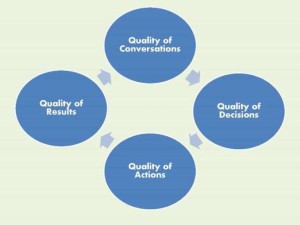Here’s a formula.
High quality conversations lead to high quality decisions, which lead to high quality actions and ultimately, high quality results and performance. The reverse is also true. Low quality conversations eventually lead to low quality results.
Achieving high quality results and performance are worth the effort to learn how to conduct high quality conversations.
 The point of leverage in this model is high quality conversations. But what is a high quality conversation?
The point of leverage in this model is high quality conversations. But what is a high quality conversation?
Unfortunately you have experienced more than your fair share of low quality conversations. These are ones where you walk out of the meeting and think any one of the thoughts below:
- “Wow, that was a complete waste of time”
- “When will people finally start to listen around here?”
- “Why does everyone have to make my life so difficult? Why won’t they listen to me?”
- “There’s no point saying what you really think around here because no one is going to listen anyway!”
High quality conversations are more natural than you might think. Peter Senge, author of the Fifth Discipline states,
As far as I know, no indigenous culture has yet to be found that does not have the practice of sitting in a circle and talking.
For the ancient Greeks dia logos was the ‘flow of meaning’. It was the cornerstone of civic practice. The polis was the gathering space for conversation. The purpose for the dia logos was about enabling self-government to occur. This system was the birthplace of the western world.
As time has passed the practice of dia logos has diminished. When you converse in a workplace your purpose is no longer to consider what is best for the whole. Rather, your purpose is to win. You are a master of debate. I win. You lose.
Our modern word for dia logos is dialogue. When we dialogue our purpose is not to win. It is to discover what no individual could discover on their own and it is to discover what is the best solution for the whole, not the part.
Think about the conversations that you have at work, especially the ones where everyone in the room is ‘representing‘ a specific department or unit. What is the intent that each of you bring to those conversations? Is it to do what is best for the whole organisation, or is it to defend, protect and/or promote what is best for your department or unit?
The root cause of the lack of dialogue in organisations is the lack of the practice of dialogue itself. Quite simply, well-educated and/or experienced people don’t know how to dialogue. The reverse is true. They know how to debate. It is little wonder that debate rules, but the overuse of debate lowers the overall quality of your conversations.
Debate is not bad. In fact a form of debate (known as ‘opposing’) is encouraged in the practice of dialogue. The issue with debating is that it is overused. Our conversations are out of balance. We require more use of dialogue to improve the quality of our conversations.
The solution is to learn dialogue together. The beauty of the learning process is that you can practice dialogue, while learning it, on real organisational issues.
In the foreword to William Isaacs’s book, ‘Dialogue and the art of thinking together‘, Peter Senge highlights that,
In almost every setting where practices of dialogue have become embedded and part of everyday routines, the ensuing changes have become irreversible, as near as I can tell.
The projects to which Senge was referring involved practical people such as line managers, executives and staff from mostly Fortune 500 companies. The improvements were clear. Improving the quality of work-place conversations improve performance.
The effort is worth it. Higher quality conversations lead to higher quality decisions which lead to higher quality actions and ultimately higher quality results and performance. Results and performance matter and so does improving the quality of conversations in your organisation.
What actions are you taking to improve the quality of conversations at your work-place?
Gary Ryan enables talented professionals, their teams and organisations to move Beyond Being Good®
If you would like to learn more about learning how to Dialogue, contact Gary here.




